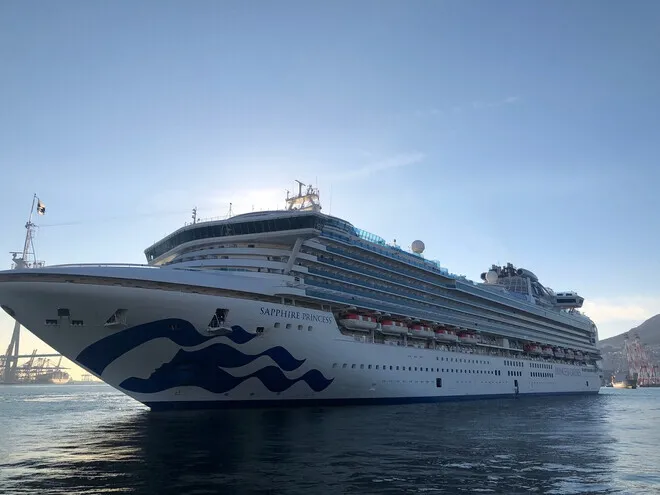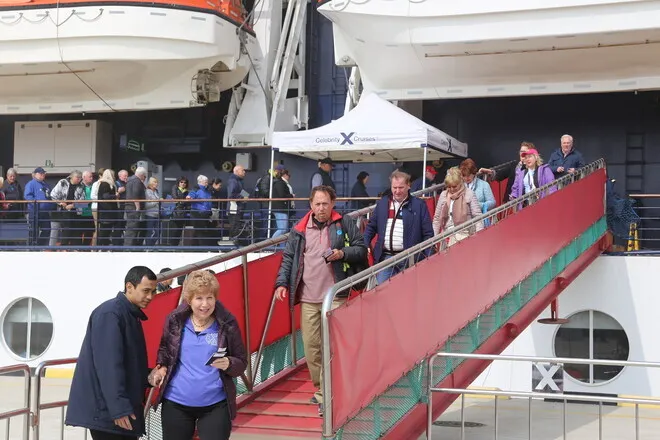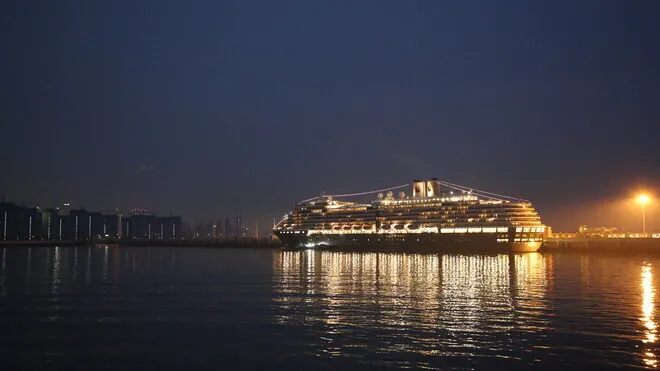hankyoreh
Links to other country sites 다른 나라 사이트 링크
[News analysis] S. Korea’s cruise industry and tourism rocked by COVID-19

After all the scrambling by local governments with ports in their area to foster and support cruise tourism, the industry is now in danger of foundering. Previously seen as a prime example of the high value-added tourism industry, it suffered reversals of fortune over several years due to China’s retaliation over the Terminal High Altitude Area Defense (THAAD) anti-missile system. With the novel coronavirus pandemic on top of that, the industry now finds itself with almost no customers. The ongoing global pandemic means that it is unlikely to recover any time soon -- deepening the woes for the local governments in question.

“There hasn’t been a single cruise ship with passengers putting in this year.”
The long sigh from Kim In-young, a department chief in the Busan Port Authority’s port industry division, could be heard across the line in a telephone interview with the Hankyoreh on June 24. Of the 180 cruise ship arrivals scheduled for Busan Port this year, 82 had been cancelled as of late June.
“After the long Lunar New Year holiday, the coronavirus began appearing in South Korea too, and since February cruise ships have been prohibited from putting in at South Korean ports,” Kim explained.
“Not a single cruise ship with passengers on it has been able to enter.”
The only cruise ships that have put in are six without passengers that arrived to load up on oil and essentials for sailing before heading on their way. With all of the major shipping companies that operate cruise ships around the world declaring a suspension through late October, observers are predicting that all scheduled arrivals for the year will end up canceled.
South Korean ports where cruise ships are capable of docking, including Jeju, Incheon, Yeosu, Sokcho, and Pohang, face the same situation. All 18 arrivals scheduled for this year at Incheon Port’s dedicated cruise ship terminal are expected to be canceled. Jeju Island, which depends heavily on China and Japan, has had no cruise ships putting in. Most of the 497 arrivals scheduled for 2020 have been canceled. Sokcho Port, which had nine cruise ship arrivals scheduled between June and November, also appears unlikely to avoid cancellations. The nature of cruise ship travel -- where hundreds to thousands of passengers and crew members spend long periods of time in close quarters -- makes them inherently vulnerable to the virus. An illustrative example was the cluster infection that erupted on the Diamond Princess, a cruise ship that docked in Yokohama, Japan, in early February. Over 700 of the 3,700 passengers and crew members on board ended up infected with COVID-19. Cluster infections have also been reported on large cruise ships docked in the US and France.

The cancelled cruise ship arrivals have dealt a blow to local economies. Everyone from the shipping agencies responsible for ferrying, towage, and crew member boarding and disembarkation when cruise ships arrive to travel agencies, charter bus companies, guides, and interpreters have seen their work dry up completely.
“With all 75 cruise ship arrival contracts booked for this year in Jeju, Busan, Incheon, and Pohang having been cancelled, US$360,000 in profits have evaporated,” said Yu Hyeon-sam, director of the Incheon office of the shipping agency Wilhelmsen Hyopwoon Ships Service.
“Our company is fortunate in that cruise ships only account for around 5% of our profits. The dedicated cruise ship businesses are on the verge of going out of business,” Yu added.
According to 2019 cruise ship statistics for Busan Port released by the city of Busan and Busan Port Authority, articles supplied to the 108 cruise ships that arrived last year totaled 60.7 billion won (US$50.7 million) in scale -- an average of 560 million won (US$467,746) or so each time. Based on the 82 Busan Port arrivals that have been cancelled so far, this means that the equivalent of 45.92 billion won (US$38.4 million) in sales have gone up in smoke. When the amount spent by cruise ship passengers at restaurants, shopping malls, and other businesses during their seven to eight hours’ stay in Busan is factored in, the ripple effect on the local economy is expected to be even larger.

The travel agencies that sell cruise ship packages are also facing deepening troubles.
“Arrival procedures around the world have become more difficult, and with the bans on cruise ship arrivals, we’re not in a place where we can promote the travel packages scheduled for October,” lamented Jeong Se-young, chief of the cruise ship business department at Lotte Tour Development. That company cancelled the two cruise ship tourism packages based out of Sokcho that it had scheduled for May of this year. The number of reservations alone reportedly amounted to over 3,000.
With cruises being especially popular among retirees with economic means, the fact that senior citizens have proven to be most vulnerable to the virus has only compounded the issues. South Korea has a particularly large number of cruise ship packages linked to mutual aid enterprises; most of those have been cancelled as well.
[%%IMAGE2%%]Dazed by THAAD, KO’d by COVIDCruise ship tourism in South Korea entered a growth period during the 2010s. According to Ministry of Oceans and Fisheries data on passengers at cruise ship ports of call, the 144 arrivals in 2011 accounted for over 153,000 passengers; five years later in 2016, the number had risen 12-fold, with over 1,953,000 passengers on 791 ships. But with the THAAD conflict bringing a drop in Chinese passengers, the numbers fell all the way to 236 arrivals and 394,000 passengers in 2017. The following year, it plummeted further to 131 arrivals and 201,000 passengers. In the three years since, there hasn’t been a single cruise ship putting in from China, and with the 1.2 million Chinese passengers who had been arriving annually now gone, Jeju International Passenger Terminal and Gangjeong Cruise Terminal in Seogwipo have been drowning in red ink. In 2016, they recorded profits of 1.04 billion won (US$868,716); since then, they’ve registered deficits of 1 billion won (US$835,304) annually. The Ministry of Oceans and Fisheries made rosy predictions of “over 3 million passengers by 2020” in its 2015 formulation of a “framework plan for developing the cruise industry,” but the reality has been the exact opposite.
Port authorities and local governments with ports in their area once scrambled to build cruise ship terminals around South Korea to gain a leg up in a market that was predicted to keep laying golden eggs. Now they sit without customers.
Jeju Island spent 60.1 billion won (US$50.2 million) building the Gangjeong Cruise Terminal, in the port of Seogwipo, only for the terminal to stand empty after two test runs in May 2018. Meanwhile, the International Cruise Terminal in Sokcho, which was opened in September 2017 with 37.3 billion won (US$31.2 million) in funding from the central government, has become a white elephant, with just five ships putting in last year.
The International Cruise Terminal that opened in the port of Incheon in April 2019 only had 10 ships put in last year. This terminal, capable of servicing the largest cruise ships, which clock in at 225,000 tons and 430m long, was built for 118.6 billion won (US$99.1 million) by the Ministry of Oceans and Fisheries and the Incheon Port Authority. The port authority is trying to find other ways to use the terminal’s empty docks, such as providing moorage for vehicle carriers, so far with little success.

As the Chinese government relaxed its ban on Korean cultural imports last year, there were hopes that the industry would recover, but the COVID-19 crisis has pushed it into an even squishier bog. Since cruise tours are the tourism packages that may well take the longest to recover, after airplane routes and national borders have completely reopened, drastic measures are necessary. This past March, the Ministry of Oceans and Fisheries started drawing up a second basic plan for promoting the cruise industry from 2021 to 2025.
“In the US, cruise ship cabins have sometimes been used to make up for the shortage of hospital beds amid the COVID-19 pandemic. That shows how much trouble the entire industry is in. We need to sell winter packages, but right now, just promoting the packages is a major headache. I think it’s going to take a long time before people regard cruises as safe again,” said Kim Jeong-ho, managing director of Dongbo Air Group, which operates the Korean office of Holland America Line, a cruise operator.
“The domestic cruise tourism industry needs to diversify passengers by reducing its dependence on specific countries and also develop packages that are linked to major tourism facilities in various areas in order to promote local consumption,” Kim said.
There are hopes in Korea’s cruise industry that the recovery here will be faster than in other countries given global awareness of Korea’s outstanding handling of the coronavirus outbreak.
By Lee Jung-ha, Incheon correspondent
Please direct comments or questions to [english@hani.co.kr]

Editorial・opinion
![[Column] Imperial tyranny, Korean humiliation [Column] Imperial tyranny, Korean humiliation](https://flexible.img.hani.co.kr/flexible/normal/500/300/imgdb/original/2025/0912/7617576652278449.jpg) [Column] Imperial tyranny, Korean humiliation
[Column] Imperial tyranny, Korean humiliation![[Correspondent’s column] Cognitive dissonance in MAGA world [Correspondent’s column] Cognitive dissonance in MAGA world](https://flexible.img.hani.co.kr/flexible/normal/500/300/imgdb/original/2025/0912/3417576648512186.jpg) [Correspondent’s column] Cognitive dissonance in MAGA world
[Correspondent’s column] Cognitive dissonance in MAGA world- [Editorial] Korea, US need a ‘gentlemen’s agreement’ on what job creation entails
- [Column] Why MAGA has its eyes set on Korea
- [Column] Lee still has his work cut out for him after summit with Trump
- [Editorial] Is this any way for the US to treat an ally?
- [Column] Lee’s difficult task of striking a balance on Japan
- [Editorial] Multipolar era means Seoul must broaden its diplomacy
- [Column] North and South Korea are no longer pawns in US-China-Russia relations
- [Column] Who we fail when we oversimplify the ‘comfort women’ issue
Most viewed articles
- 1Seoul says US must fix its visa system if it wants Korea’s investments
- 2North Korea said to have exposed numerous US spies after botched 2019 SEAL mission
- 3Freed workers arrive in Korea, one week after ICE raid in Georgia
- 4[Column] Imperial tyranny, Korean humiliation
- 5[Column] Why MAGA has its eyes set on Korea
- 6MAGA’s traveling circus comes to Korea
- 7Korea’s president says firms will be ‘very hesitant’ about investing in US after ICE raid
- 8[Correspondent’s column] Cognitive dissonance in MAGA world
- 9Lee says he won’t sign any tariff deal with US that doesn’t benefit Korea
- 10Son of ex-President Roh Tae-woo tapped to serve as ambassador to China